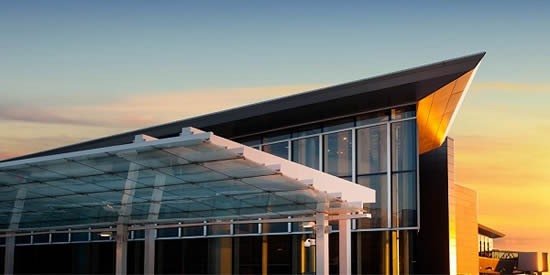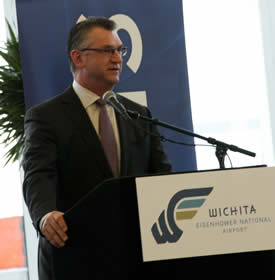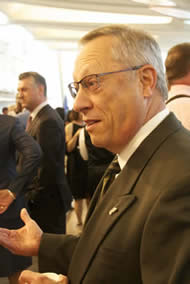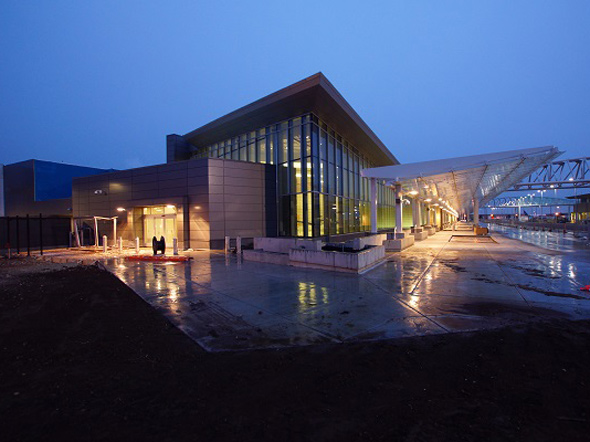Air Capital Gets a Second Chance at a First Impression
04.14.15 · Sonia Greteman
Wichita’s Air Capital status draws travelers from around the world. They jet here to meet with people at Spirit AeroSystems, Textron Aviation, Bombardier Learjet, the National Center for Aviation Research, aviation suppliers and more. In a month or so, visitors flying into the former Mid-Continent Airport will find quite a different welcome. Wichita just got a $200-million front door.
Can’t wait to check it out? Let me be your guide.
Even if you don’t see the signs that now read Wichita Dwight D. Eisenhower National Airport, you’ll experience a difference. You disembark through glass, climate-controlled jetways. As you enter the gate, you step into a gleaming new, 275,000-square-foot terminal.

Skylights infuse the soaring interior with one of my favorite things – natural light. The ceiling looks like a giant aircraft interior. Terrazzo floors with nickel-inlaid patterns inspired by contrails create an intuitive traffic flow. Supergraphics along the concourse highlight some of the 100-plus key models of the approximately 300,000 aircraft built here, from single-seat biplanes to transatlantic jumbo jets.
Exiting the large, open security area and its public-art, cloud-like ceiling treatment, you find aviation touches throughout the terminal. From the wing-shaped swooping roofline to the moderne industrial surfaces, the entire building feels like a metaphor for aviation today.
Celebration of the Air Capital
When you land on the mezzanine you’re transported to the early days of flight through a series of six wing-shaped pods, each telling a unique story of Wichita’s colorful past and future. Research and photos range from the early birds, barnstormers, WWII to modern day. The center circular panel explains why Wichita became the Air Capital: the central location, lots of clear sunny days to fly, flat enough that pilots could land anywhere, farmer-mechanics who could fix and build anything, and the influx of oil money to invest in an emerging industry.
Two-story-high exterior walls of blast-resistant glass let light stream in while offering protection in severe weather. Take an escalator or elevator down to the main floor. I recommend the escalator. It provides an excellent vantage point for Portland, Oregon-based artist Ed Carpenter’s Ascent Decent public art. Dichroic glass panels designed to resemble interior wing spars arch overhead from taut steel cables 360 feet long – more than the length of a football field.

On the main floor, Allegiant, American, Delta, Southwest and United ticketing areas sit to the west; baggage claim to the east.
Basement conveyor belts transport luggage – accommodating golf-club-size bags – while TSA explosives-detection machines scan away.
A covered exterior walkway leads the way to the airport’s first-ever parking garage. It houses rental-car services on the main level, covered parking on two levels, and uncovered parking on the top.
Why the Change to Eisenhower National Airport
Wichita’s current public terminal opened in 1954 when Dwight Eisenhower was president. A grassroots campaign 60 years later led to a renaming. Aviation actually played a major role in our 35th president’s legendary life.
As WWII Supreme Allied Commander in Europe, he had final say on how to use thousands of warplanes (many built in Kansas). He was the first president to have his pilot’s license. The first to ride in a helicopter. The first to fly in the jet called Air Force One. He propelled the world into the space age by establishing the National Aeronautics and Space Administration (NASA). He signed the act that created the Federal Aviation Administration (FAA).
President Eisenhower grew up in Abiline, Kansas, but he lived his life on the world stage. Fighting for peace. Laying the groundwork for innovation. We like Ike. That said the airport code for Wichita Eisenhower National Airport will remain the same – ICT nationally and KICT internationally. No change to IKE.
From There to Here

Talks for the new terminal began in 2002. Our agency, Greteman Group has been involved since 2004 – leading the selection of the public art consultant and creating the history of Wichita aviation displays. It has the distinction of being the oldest project in our shop. And, while it proceeded in fits and starts – following the economy’s ups and downs – we never lost our passion for it.
Victor White, Executive Director of Airports for the Wichita Airport Authority, says he essentially has had two jobs since coming on board in 2005 – managing the existing airport and planning the new terminal. When you fly into Wichita, I believe you’ll agree that he’s done a great job. I’m hoping you’ll enjoy the outcomes of our role as well.
This column ran in the April 16 issue of BlueSky Business Aviation News.

